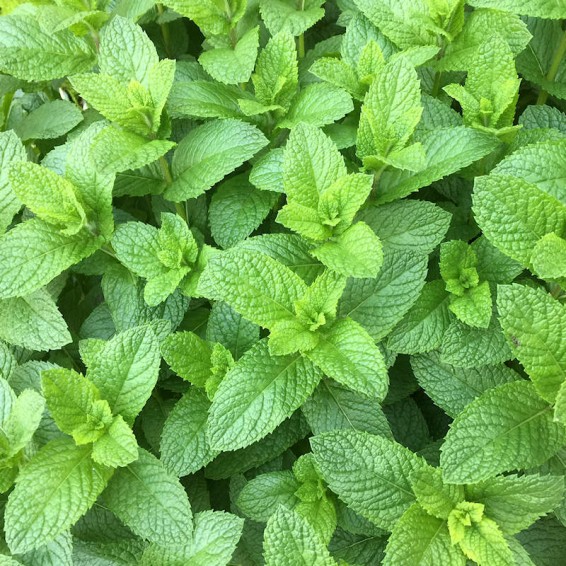Spearmint Seeds
- HOW TO GROW
- FAST FACTS
- REVIEWS
HOW TO GROW
Sowing: Mint grows well in rich soil and partial shade, and damp soil. Direct sow spearmint seeds after the last spring frost, thinning the seedlings to 10-12". Keep in mind that mint spreads easily and can nearly take over the space it is planted in. Because of this, some gardeners prefer to grow mint in an isolated location or as a container plant because of its vigorous spreading habit. As a companion plant, mint benefits nearly every garden plant and repels many harmful insects. Mint also grows well from root cuttings or by division.
Growing: Mint appreciates rich soil, and will benefit from organic matter such as compost. Keep the soil fairly moist, but avoid getting the leaves wet when watering, since this can cause disease. In areas with cold winters, cut the plant down to the ground after frost and provide a thick layer of mulch for protection.
Harvesting: Fresh leaves can be harvested as soon as the plant reaches a height of 3-4". The small, young leaves tend to have the best flavor. Cut the stems down to within 1" of the ground level to allow for new growth. Keep the tops pruned to prevent blooming, since this causes the leaves to deteriorate in flavor. To dry the leaves, hang the stems upside down in a dry location until the leaves feel completely dry; strip them from the stems and keep them in an airtight container. Fresh mint leaves can also be frozen.
Seed Saving: Since many types of mint produce sterile seed or seed that is not true to type, saving the seed may be somewhat of an experiment. Harvest the seed heads as soon as they grow dry and brown; spread them out to finish drying out of sunlight, then thresh them to remove the seed. Store the spearmint seeds in a cool, dry place.
FAST FACTS
Common Names: Garden Mint, Common Mint, Lamb Mint, Mackerel Mint
Latin Name: Mentha spicata
Species Origin: Europe, Asia, Middle East, Asia, China
Type: Open Pollinated, Heirloom, Cool Season|Warm Season
Life Cycle: Perennial
USDA Zones: 4, 5, 6, 7, 8, 9
Seeds per Ounce: 100,000
Planting Method: From Transplant
Sunlight: Full Sun, Part Sun
Height: 30 Inches
Color: White, Green
Bloom Season: Blooms Early Summer, Blooms Late Summer
Uses: Attracts Pollinators, Attracts Honeybees, Aromatic
Spearmint Seeds
Everwilde has the best quaily at the best price for their seeds! Delivered fast and great customer service. I am so thankful for Everwide seed company!
Ground cover 2
I also have wild mint, this I use for some of my cooking recipes and cold drinks. This isn't picky on soil for me, it grows where I put it. Both mint and spearmint I have around my house on to help keep down the mosquitoes.
Spearmint
Awesome Seller!
Fast germination
Germinated in just a few days. Another great find from Everwilde.
DESCRIPTION
HOW TO GROW
Sowing: Mint grows well in rich soil and partial shade, and damp soil. Direct sow spearmint seeds after the last spring frost, thinning the seedlings to 10-12". Keep in mind that mint spreads easily and can nearly take over the space it is planted in. Because of this, some gardeners prefer to grow mint in an isolated location or as a container plant because of its vigorous spreading habit. As a companion plant, mint benefits nearly every garden plant and repels many harmful insects. Mint also grows well from root cuttings or by division.
Growing: Mint appreciates rich soil, and will benefit from organic matter such as compost. Keep the soil fairly moist, but avoid getting the leaves wet when watering, since this can cause disease. In areas with cold winters, cut the plant down to the ground after frost and provide a thick layer of mulch for protection.
Harvesting: Fresh leaves can be harvested as soon as the plant reaches a height of 3-4". The small, young leaves tend to have the best flavor. Cut the stems down to within 1" of the ground level to allow for new growth. Keep the tops pruned to prevent blooming, since this causes the leaves to deteriorate in flavor. To dry the leaves, hang the stems upside down in a dry location until the leaves feel completely dry; strip them from the stems and keep them in an airtight container. Fresh mint leaves can also be frozen.
Seed Saving: Since many types of mint produce sterile seed or seed that is not true to type, saving the seed may be somewhat of an experiment. Harvest the seed heads as soon as they grow dry and brown; spread them out to finish drying out of sunlight, then thresh them to remove the seed. Store the spearmint seeds in a cool, dry place.
FAST FACTS
Common Names: Garden Mint, Common Mint, Lamb Mint, Mackerel Mint
Latin Name: Mentha spicata
Species Origin: Europe, Asia, Middle East, Asia, China
Type: Open Pollinated, Heirloom, Cool Season|Warm Season
Life Cycle: Perennial
USDA Zones: 4, 5, 6, 7, 8, 9
Seeds per Ounce: 100,000
Planting Method: From Transplant
Sunlight: Full Sun, Part Sun
Height: 30 Inches
Color: White, Green
Bloom Season: Blooms Early Summer, Blooms Late Summer
Uses: Attracts Pollinators, Attracts Honeybees, Aromatic
Reviews
Review
Spearmint Seeds
Everwilde has the best quaily at the best price for their seeds! Delivered fast and great customer service. I am so thankful for Everwide seed company!
Review
Ground cover 2
I also have wild mint, this I use for some of my cooking recipes and cold drinks. This isn't picky on soil for me, it grows where I put it. Both mint and spearmint I have around my house on to help keep down the mosquitoes.
Review
Spearmint
Awesome Seller!
Review
Fast germination
Germinated in just a few days. Another great find from Everwilde.





